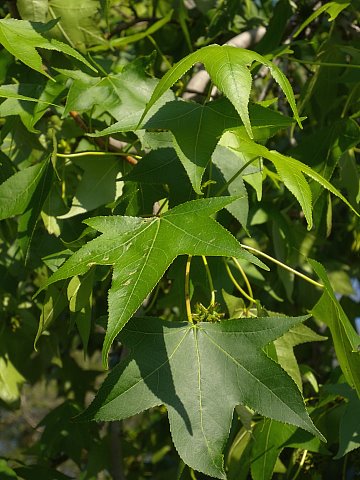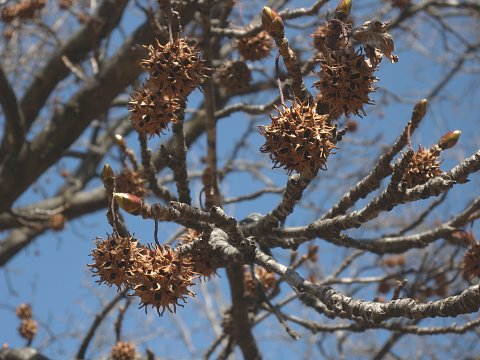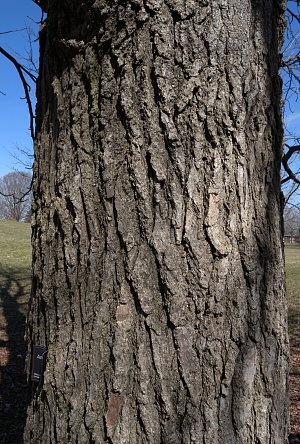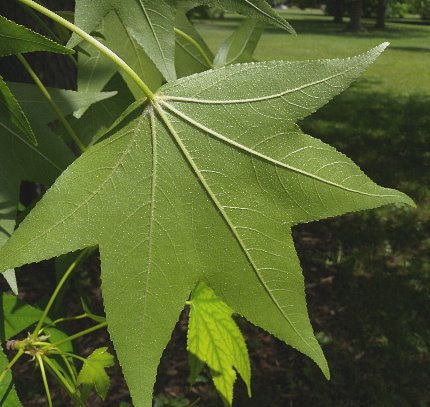
Sweet Gum is monoecious, producing separate male (staminate) and female (pistillate) flowers on the same tree. The male inflorescence consists of a raceme of clustered male flowers about 1-2½" long; this raceme is greenish yellow and ascending. Individual male flowers are about 1/8" (3 mm.) across, consisting of 4-8 fertile stamens that originate from a short disc. The stalks of the raceme are hairy. The female inflorescence consists of a green globoid head of female flowers about ¾" across; this floral head droops downward from a stalk (peduncle) about 1-3" long; the stalk is light green and glabrous. Individual female flowers are about 1/8" (3 mm.) across, consisting of a 2-celled ovary with 2 spreading styles and 4-8 sterile stamens (staminodes). The blooming period occurs during mid- to late spring shortly after the emergence of vernal leaves. The flowers are cross-pollinated by the wind.

During the summer, the female inflorescences become transformed into spiky seed capsules about 1-1½" across, turning brown at maturity during the autumn. Between each pair of hardened styles, each seed capsule splits open to release 1-2 seeds. Usually, only a minority of capsules in each head produce fertile seeds. These seeds are about 1/3" (8 mm.) long, flattened, and winged; they are distributed by the wind. The empty heads of seed capsules often persist on the tree through the winter. In dry areas, the root system consists of a well-devloped taproot and lateral roots, while in soggy areas it consists of lateral roots that are shallow and widely spreading. The deciduous leaves can assume various colors during the autumn, including yellow, orange, red, pink, or dark purple.
 Cultivation:
The preference is full
or partial sun, moist conditions, and fertile soil containing loam or
clay-loam. Alkaline soil can cause difficulty in absorbing iron and
other nutrients, therefore it should be avoided. Occasional flooding is
tolerated if it is relatively short in duration. Seedheads are produced
on trees about 25 years old and annually thereafter. The biggest
drawback in cultivating this tree is the abundance of spiky seedheads
that fall to the ground from autumn to spring. In addition to their
unsightly appearance, they are difficult to walk on and require
additional labor to remove.
Cultivation:
The preference is full
or partial sun, moist conditions, and fertile soil containing loam or
clay-loam. Alkaline soil can cause difficulty in absorbing iron and
other nutrients, therefore it should be avoided. Occasional flooding is
tolerated if it is relatively short in duration. Seedheads are produced
on trees about 25 years old and annually thereafter. The biggest
drawback in cultivating this tree is the abundance of spiky seedheads
that fall to the ground from autumn to spring. In addition to their
unsightly appearance, they are difficult to walk on and require
additional labor to remove.Range & Habitat: The native Sweet Gum is occasional in southern Illinois, otherwise it is largely absent from natural areas of the state (see Distribution Map). Illinois lies along the NW range-limit for this tree; it common in many areas of southeastern United States. Habitats consist of depressions in upland woodlands, bottomland woodlands, riverbanks, drier areas of swamps, shaded gravelly seeps, and abandoned fields. Sweet Gum requires occasional disturbance to create openings in wooded areas that it can colonize. Otherwise, it is replaced by more shade-tolerant trees. Sweet Gum is often cultivated as a landscape tree in yards and parks.
Faunal Associations: Compared to other trees, very few insects appear to feed on Sweet Gum. The caterpillars of the moths Actias luna (Luna Moth) and Paectes abrostoloides (Large Paectes) feed on the leaves of this tree, while larvae of the bark beetle Pityophthorus liquidambarus infest damaged or dead trees. The seeds are a source of food to some songbirds during the fall or winter: these species include the Mourning Dove, Eastern Towhee, Carolina Chickadee, Eastern Goldfinch, Purple Finch, Common Redpoll, Slate-Colored Junco, and White-Throated Sparrow. In addition, the seeds are a minor source of food for the Gray Squirrel and Eastern Chipmunk. When Sweet Gum occurs near bodies of water, the Beaver occasionally uses its wood and branches for food and construction materials.
Photographic Location: The Arboretum of the University of Illinois and along a sidewalk in a residential area of Urbana, Illinois.

Comments: This tree has distinctive star-shaped leaves, making it relatively easy to identify. The wood is occasionally used to make veneer, furniture, boxes and crates, rail ties, pulpwood, and other items, but it has a tendency to shrink and warp. A fragrant gum is produced from the sap of Sweet Gum that is referred to as 'American Storax.' It has been used as a fixative for perfumes, to lend fragrance to ladies' apparel, and other applications. The crushed leaves also exude a pleasant fragrance. Some authorities assign this tree to the Witch Hazel family (Hamamelidaceae), but recent genetic evidence suggests that it is not closely related to species in this family. Fossil evidence suggests that trees in the Sweet Gum family were more common and widely distributed in the past than they are at present.